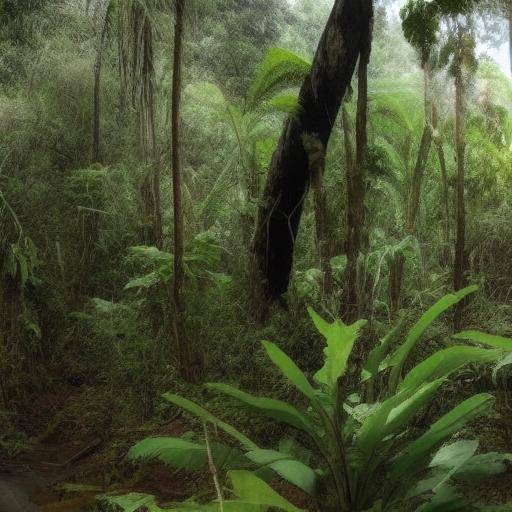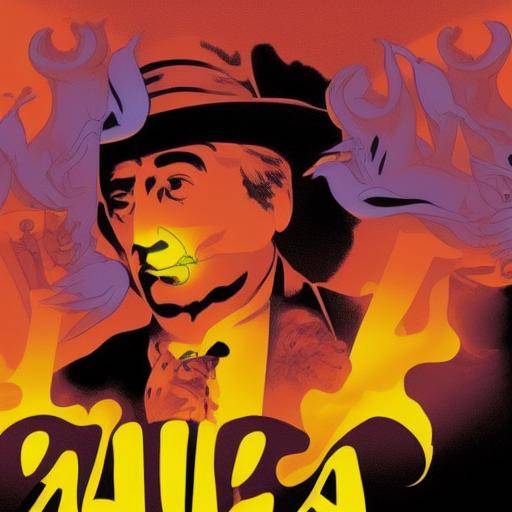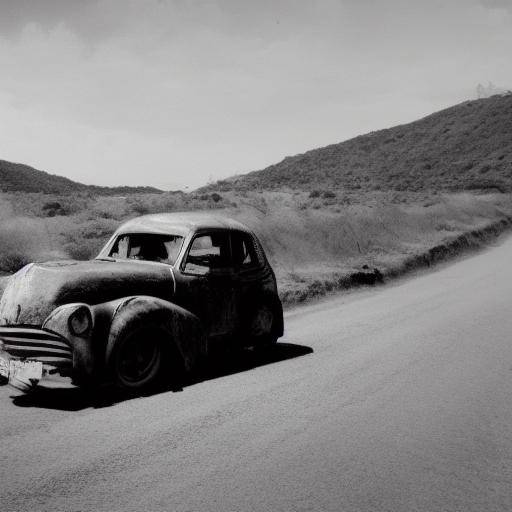
The folklore of Central America is full of mystical creatures that have intrigued generations with their intriguing stories and mysterious origins. One of the most fascinating and feared beings is the Cadejo, a spectral dog that, according to popular tradition, lurks the roads and travelers of the region. In this article, we will explore in depth the figure of the Cadejo, its connection with El Salvador, and its role in the roads of Central America. From its origin to the most recent accounts, we will discover the mystery behind this enigmatic creature and its impact on Central American culture.
Introduction
The Cadejo is an emblematic figure in the Central American legends, known for its spectral appearance and its connection to the roads and travelers. His presence has been the subject of countless accounts and has generated countless interpretations over time. In this article, we will unravel the roots of this fascinating creature, examine its role in the context of El Salvador and explore its presence in the paths of Central America.
Get ready to enter the mysterious world of Cadejo and discover its deepest secrets!
History and Background
The Cadejo has its roots in the pre-Columbian traditions of Central America, where it was associated with protective and vigilant entities. Over time, the figure of the Cadejo has been intertwined with the beliefs and mythologies of the region, giving rise to different interpretations and accounts that vary according to culture and time.
Origins and Evolution
The origin of the Cadejo dates back to the ancient beliefs of the indigenous cultures of Central America, where he was attributed both benevolent and malignant qualities. Over the centuries, the Cadejo myth has evolved, adopting different forms and meanings in the different communities of the region. This evolution has led to a rich tradition of stories and legends that have kept alive the presence of the Cadejo in the minds and hearts of people.
Meaning and Symbolism
The Cadejo not only represents a mythical figure, but also embodies deeper concepts in the Central American worldview. His role as a guardian of the roads and protector of the travelers makes him a symbol of the uncertainty, mystery and duality of life itself. Their symbolic presence transcends the borders of mythology, reaching an emotional and spiritual meaning for those who have grown up listening to their stories.
Historical and Anecdotes Cases
Throughout history, numerous accounts on Cadejo sightings have been documented in the roads of Central America. These anecdotes vary in detail and tone, but they share the atmosphere of mystery and wonder that surrounds this enigmatic creature. In exploring these historical cases, we can glimpse the footprint that the Cadejo has left in the popular culture and collective imagination of the region.
Analysis in Deep
The role of Cadejo in Central American society goes beyond mere superstition, as its presence has influenced the art, literature and cultural identity of the region. Reviewing its impact from different perspectives allows us to appreciate the complexity and relevance of the Cadejo myth in the contemporary context.
Cultural and Artistic Influence
The Cadejo has inspired a wide range of artistic expressions, from paintings and sculptures to popular narratives and traditional music. His image has been immortalized in Central American iconography, serving as a symbol of identity and connection with cultural roots. By investigating the influence of Cadejo in art and culture, we can appreciate its lasting legacy in the collective imagination of the region.
Contemporary Manifestations
Although the Cadejo myth comes from ancestral traditions, its presence has remained alive in the collective consciousness of the Central American communities over time. Even in the modern era, the Cadejo remains a topic of conversation and debate, appearing in films, novels, and other contemporary media. This persistence demonstrates the lasting influence of the Cadejo in popular culture, as well as its ability to adapt to social and technological changes.
Comprehensive review
The role of Cadejo in the social and cultural fabric of Central America goes beyond its mythical nature, affecting tangible aspects of everyday life and local traditions. By thoroughly examining their presence in the roads and their influence in the region, we can better understand their impact and relevance today.
Myths and Realities in the Ways of Central America
The roads of Central America have witnessed countless stories and sightings related to the Cadejo, generating a framework of myths and realities that persist in the collective imagination. By exploring these stories, we can glimpse the connection between the Cadejo myth and the lived experience of those who travel along the paths of the region.
Related Traditions and Celebrations
The Cadejo myth has also permeated the traditions and celebrations of Central America, enriching local festivities and folkloric practices. His presence is manifested in rituals, dances and theatrical representations that honor the figure of the Cadejo, highlighting its importance in the cultural and religious life of the region.
Current and Future Perspectives
As Central American society evolves, the Cadejo myth faces new challenges and opportunities to endure in the collective imagination. Exploring current and future perspectives allows us to glimpse the continued relevance of the Cadejo in a constantly changing world, as well as its potential to inspire new generations and remain an integral part of Central American cultural heritage.
Comparative analysis
To fully understand the meaning and significance of the Cadejo myth, it is essential to explore its context in relation to El Salvador and the paths of Central America. By comparing these elements, we can glimpse a more complete picture of the influence of the Cadejo in the region and its role in the lives of its inhabitants.
Cadejo, El Salvador and Caminos: Similarities and Differences
The Cadejo, although present in various Central American cultures, has acquired specific nuances in El Salvador, where its presence and meaning can differ from other regions. In analyzing these similarities and differences, we can appreciate the diversity of interpretations and experiences associated with the Cadejo myth in the Salvadoran context and in relation to the paths that cross their territory.
Regional Legends and Legends
The stories and legends about the Cadejo vary according to the region, each with its own narrative wealth and cultural particularities. By comparing these accounts, we can discover the many facets of the Cadejo myth and its role in the formation of local identities in Central America, detecting the specific influences of the traditions and mythologies of each region.
Impact on Culture and Society
The presence of the Cadejo is not only limited to the realm of popular beliefs, but it extends to the culture, society and daily lives of those who live in the vicinity of their domains. By comparing its impact in different contexts, we can understand how the Cadejo myth has shaped the perception of the environment and human interaction in relation to the roads and the Central American territory.
Practical Tips and Accessible Recommendations
Although the Cadejo myth resonates mainly in the field of folklore, its presence has left an indelible mark on the culture and society of Central America. In considering the relevance of the Cadejo, both in historical and contemporary contexts, it is possible to draw practical lessons and recommendations that contribute to a deeper and more enriching understanding of its meaning.
Tips for Travelers and Explorers
For those who are curious about exploring the paths and paths of Central America, it is useful to take into account local traditions and myths that can influence the travel experience. Knowing the stories about the Cadejo can add an additional layer of meaning and astonishment to each journey, enriching the sense of adventure and discovery in natural and cultural space.
Preservation of Cultural Heritage
The Cadejo myth is part of the cultural heritage of Central America, a legacy that deserves to be preserved and transmitted to future generations. By assessing and promoting the conservation of these traditions, it contributes to the safeguarding of a rich cultural heritage that enriches the diversity and sense of identity of the region.
Critical Exploration of Popular Beliefs
Although the Cadejo myth is appreciated for its intrinsic value as part of oral tradition and popular mythology, it is also important to address it from a critical and reflective perspective. Analyzing popular beliefs with an attentive and respectful look allows us to understand their meaning in the social and cultural life of communities, as well as their influence on the way we interpret the world around us.
Industry Perspectives and Expert Reviews
The Cadejo myth has captured the imagination of researchers, anthropologists, and artists, who have contributed to deepening their meaning and relevance in the context of Central America. In considering the opinions of experts and the perspectives of industry, it is possible to enrich our understanding of the Cadejo and its implications in the cultural and social life of the region.
Reflections of Local Experts
The knowledge about the Cadejo myth is enriched with the perspectives of local experts who have studied or researched their influence on Central American culture and society. The reflections of these experts offer a contextualized and enriching vision that brings us closer to a deeper understanding of the importance of Cadejo in the region.
Interdisciplinary Vision
The influence of the Cadejo myth encompasses different disciplines, from anthropology to literature and sociology. The interdisciplinary vision of experts in these areas allows us to address the Cadejo myth from multiple perspectives, revealing complex connections and deepening their meaning in relation to the culture and society of Central America.
Future Projections and Trends
In considering the legacy of the Cadejo myth, experts also offer future projections and trends that can impact their presence and significance in the region. These reflections invite us to contemplate the continued role of the Cadejo in Central American culture and the possible directions that its influence could take in the future.
Case Studies and Real Life Applications
The myth of the Cadejo, although rooted in tradition and mythology, has also found expression in the daily life and personal experiences of those who have kept their presence alive over time. By exploring case studies and applications in real life, we can understand how the Cadejo myth has influenced different areas of Central American life.
Personal Records and Livelihoods
Throughout generations, people have shared their own experiences and experiences related to the Cadejo myth, giving it an intimate and personal dimension. These stories allow us to appreciate how the Cadejo has impacted the lives of individuals and communities, enriching their perception of the world around them.
Family and Community traditions
The Cadejo myth has been transmitted through generations, rooting in family and community traditions that have preserved their stories and meanings over time. Studying these traditions offers us a vision of the importance of Cadejo in the context of the daily life and collective memory of the Central American communities.
Presence in Popular Culture
The Cadejo myth is not limited to folk tales, but is manifested in popular culture through artistic expressions, local festivities, and daily practices. By exploring its presence in popular culture, we can understand how the Cadejo has gained life in the collective imagination and influenced how people perceive and celebrate their cultural heritage.
Future Trends and Predictions
As Central America faces new challenges and opportunities in the twenty-first century, the Cadejo myth is also at a time of reflection and transformation. In considering future trends and predictions related to the Cadejo myth, it is possible to glimpse its continuing impact on the region and its role in shaping the cultural and social identity of the Central American communities.
Adaptation to the Digital Era
In a context of technological and social change, the Cadejo myth faces the opportunity to adapt to new forms of communication and expression. The presence of the Cadejo in digital space and its influence on contemporary narratives reveal the ability of the myth to reinvent and find resonance in current generations.
Integration in Education and Culture
The Cadejo myth is also finding its place in contemporary education and culture, where it is recognized as a valuable element in promoting the understanding and appreciation of Central American cultural diversity. Its integration into educational programmes and cultural initiatives projects a future in which the Cadejo continues to enrich the identity and collective awareness of the region.
Challenges and Opportunities in the 21st Century
The Cadejo myth faces challenges and opportunities in a constantly evolving world, where popular traditions and beliefs are subject to change and reinterpretation. Understanding these challenges and opportunities allows us to reflect on the continued role of the Cadejo in Central American culture and society, as well as its ability to adapt and transcend the borders of time.
Conclusion
The Cadejo myth continues to captivate the imagination and to light the curiosity of those who immerse themselves in their stories and meanings. Their presence in Central American culture and society remains a testament to the perdurability of folk traditions and their ability to inspire, astonish, and connect people through time and space.
As we explore the roots, impact and future of the Cadejo myth, we immerse ourselves in a world of mystery, emotion, and reflection, where the borders between the real and the imaginary blur and invite us to contemplate the richness of the human narrative and its influence in the configuration of the world we inhabit.
Frequently asked questions
1. What does the Cadejo myth have in Central American culture?
The Cadejo myth is highly significant in Central American culture, where it is considered a guardian of the roads and a figure that embodies essential dualities in the region's worldview.
2. What is the historical origin of the Cadejo myth?
The historical origin of the Cadejo myth dates back to the pre-Columbian traditions of Central America, where it was associated with protective and vigilant entities.
3. How does the Cadejo myth manifest in the daily lives of the Central American communities?
The Cadejo myth is manifested in everyday life through family traditions, local holidays, artistic expressions, and popular beliefs that have preserved their meaning and relevance over time.
4. What lessons can we draw from the Cadejo myth in the contemporary context?
In the contemporary context, the Cadejo myth offers lessons on the importance of preserving and assessing cultural traditions, as well as the ability of popular beliefs to enrich the social and spiritual life of communities.
5. What is the impact of the Cadejo myth on Central American art and literature?
The Cadejo myth has inspired a wide range of artistic and literary expressions, helping to enrich the iconography and cultural narrative of Central America over the centuries.
6. What is the future of the Cadejo myth in Central American culture?
The future of the Cadejo myth is projected as an integral part of the cultural and social identity of Central America, where its presence continues to inspire new forms of expression and appreciation for the cultural diversity of the region.
The myth of the Cadejo, with its rich history and its lasting influence on Central American culture, remains a beacon of wonder, reflection, and connection with the deepest roots of the region. As we explore its meaning and presence in the life of the communities, we enter a world of mystery and admiration, which resonates in the traditions and beliefs that have shaped the unique character of Central America.



